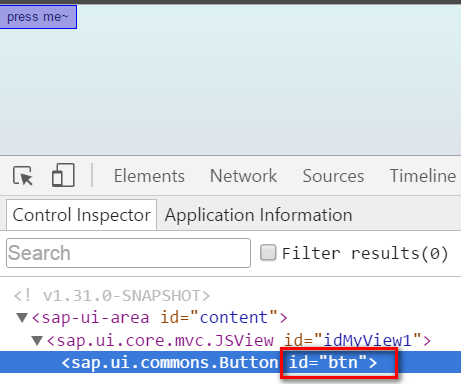
- SAP Community
- Products and Technology
- Technology
- Technology Blogs by SAP
- An easy way to find location where Unique id of UI...
- Subscribe to RSS Feed
- Mark as New
- Mark as Read
- Bookmark
- Subscribe
- Printer Friendly Page
- Report Inappropriate Content
We know that when we create a new UI5 control instance, we can explicitly pass an id into constructor. In this case, developer takes responsibility to ensure the id is unique.

We can find the unique id in rendered page.

An alternative is we do not pass any id but let UI5 framework to automatically generate one.
Above code will have a button with id "__button0" generated.

Question: how can I find exactly location of code where UI5 does the trick?
Since I don't know exactly where should I start to debug, I even do not know which js file I should start with.
As a result, I plan to manually bring some trouble to UI5 framework, so that it can raise some complain message in Chrome development tool console to give me some idea. So I write the following code. I assume line 11 will lead to some mistake due to the duplicate control id.

When I refresh the application, I see the expected error message in console. Ckick the third frame in callstack: Core.registerElement to view its source code:

Here below we can understand the UI5 framework logic how to detect duplicate control id:
1. There is a central repository to store all registered control instance. See this.mElements in line 40711.
2. in line 40700, scan against the central repository with the id of new control to be registered. If byId returns one, it means there is already existing control with the same id. Duplication detected!


So far we still do not know where id is generated. Type oElement.getId in console and the source code of this function is printed out. Then we know for every control instance, it has a property sId to store its ID.

Perform key word search within the same JS file where registerElement is implemented with keyword ".sId", only 11 matches found.
Then we find a constructor function which looks like just what I am looking for. The logic of automatic ID generation if not explicitly specified is implemented between line 29062 and 29064. Set a breakpoint to verify our guess.

Write the following code in controller:
var myButton = new sap.ui.commons.Button({
text: "press me~"
});
In the runtime breakpoint is triggered.

The ID fragment, "button", comes from this.getName() in line 33711.

UI5 framework internally maintains a counter as the postfix of each control id.

This is the reason why we can see lots of number postfix in every UI5 application:

- SAP Managed Tags:
- SAP Fiori
You must be a registered user to add a comment. If you've already registered, sign in. Otherwise, register and sign in.
-
ABAP CDS Views - CDC (Change Data Capture)
2 -
AI
1 -
Analyze Workload Data
1 -
BTP
1 -
Business and IT Integration
2 -
Business application stu
1 -
Business Technology Platform
1 -
Business Trends
1,658 -
Business Trends
92 -
CAP
1 -
cf
1 -
Cloud Foundry
1 -
Confluent
1 -
Customer COE Basics and Fundamentals
1 -
Customer COE Latest and Greatest
3 -
Customer Data Browser app
1 -
Data Analysis Tool
1 -
data migration
1 -
data transfer
1 -
Datasphere
2 -
Event Information
1,400 -
Event Information
66 -
Expert
1 -
Expert Insights
177 -
Expert Insights
298 -
General
1 -
Google cloud
1 -
Google Next'24
1 -
Kafka
1 -
Life at SAP
780 -
Life at SAP
13 -
Migrate your Data App
1 -
MTA
1 -
Network Performance Analysis
1 -
NodeJS
1 -
PDF
1 -
POC
1 -
Product Updates
4,577 -
Product Updates
344 -
Replication Flow
1 -
RisewithSAP
1 -
SAP BTP
1 -
SAP BTP Cloud Foundry
1 -
SAP Cloud ALM
1 -
SAP Cloud Application Programming Model
1 -
SAP Datasphere
2 -
SAP S4HANA Cloud
1 -
SAP S4HANA Migration Cockpit
1 -
Technology Updates
6,873 -
Technology Updates
421 -
Workload Fluctuations
1
- Extend Your Crystal Reports Solutions in the DHTML Viewer With a Free Function Library in Technology Blogs by Members
- Onboarding Users in SAP Quality Issue Resolution in Technology Blogs by SAP
- Handle the behavior of extension field by toggle button using SDK UI designer. in Technology Blogs by Members
- IoT - Ultimate Data Cyber Security - with Enterprise Blockchain and SAP BTP 🚀 in Technology Blogs by Members
- Developing & Deploying the UI5 App to Cloud Foundry and Accessing from App-router End-to-End Steps in Technology Blogs by Members
| User | Count |
|---|---|
| 38 | |
| 25 | |
| 17 | |
| 13 | |
| 7 | |
| 7 | |
| 7 | |
| 7 | |
| 6 | |
| 6 |